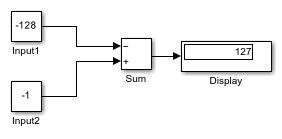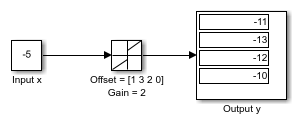Display
Show value of input
Libraries:
Simulink /
Sinks
HDL Coder /
Sinks
Description
The Display block shows the value of the input data. You can specify the frequency of the display. For numeric input data, you can also specify the format of display.
If the block input is an array, you can resize the block vertically or horizontally to show more than just the first element. If the block input is a vector, the block sequentially adds display fields from left to right and top to bottom. The block displays as many values as possible. A black triangle indicates that the block is not displaying all input array elements.
The Display block shows the first 200 elements of a vector signal and the first 20 rows and 10 columns of a matrix signal.
Note
If you specify a numeric display format that is not large enough to display all the digits of a value, the displayed values may lose precision. The result depends on your computer hardware and operating system.
Display Abbreviations
The following abbreviations appear on the Display block to help you identify the format of the value.
| When You See... | The Value That Appears Is... |
|---|---|
| The stored integer value Note
|
| In hexadecimal format |
| In binary format |
| In octal format |
Displaying Strings
When working with strings, the Display block displays:
Strings with double quotes.
Special characters such as newline are shown as escaped sequences, for example
'\n'.Non-displayable characters as escaped octal number, for example
'\201'.
If the incoming signal is of type string, the Numeric display format parameter selection does not affect the display of the string.
Examples
Extended Examples
Ports
Input
Parameters
Block Characteristics
Data Types |
|
Direct Feedthrough |
|
Multidimensional Signals |
|
Variable-Size Signals |
|
Zero-Crossing Detection |
|
Extended Capabilities
Version History
Introduced before R2006a
See Also
Scope | To File | To Workspace






